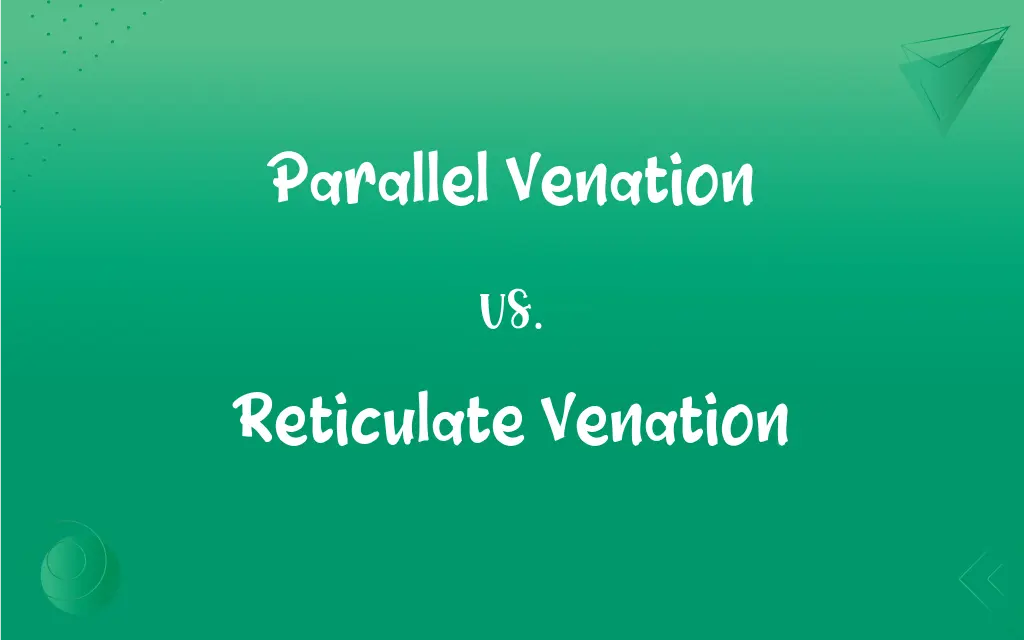Parallel Venation vs. Reticulate Venation: What's the Difference?
Edited by Janet White || By Harlon Moss || Updated on October 13, 2023
Parallel venation means veins in leaves run side-by-side, without intersecting, common in monocots; reticulate venation involves a branching, net-like vein arrangement, typical in dicots.

Key Differences
Parallel venation and reticulate venation represent two distinct patterns of vascular arrangement in the leaves of plants, each characteristic of different classifications of plants. Parallel venation features veins that run side-by-side, parallel to each other, and never intersect or join, usually found in monocotyledon plants. On the contrary, reticulate venation demonstrates a network of veins that branch out and intersect each other, forming a complex, net-like pattern, prevalent in dicotyledon plants.
In the realm of parallel venation, the veins are straight and run in unison from the base to the tip of the leaf, providing a uniform and orderly appearance. This is opposed to the framework of reticulate venation, where the veins form an intricate network, displaying a much more complex and varied path throughout the leaf tissue. The veins in reticulate venation often include one prominent central vein from which smaller veins branch out, thereby creating a meshed pattern.
Examining plants with parallel venation, it's noticeable that they exhibit a straightforward, non-complex venation pattern, where the veins run side-by-side without connecting with each other. In contrast, in plants with reticulate venation, the larger, primary veins are connected through smaller, secondary veins, producing a continuous network across the leaf surface, providing both structural integrity and a channel for resources.
One can observe parallel venation predominantly in the leaves of monocot plants, which have one cotyledon, such as grasses and lilies, representing a simplicity and uniformity in their structural vein pattern. Conversely, reticulate venation is most often observed in dicot plants, which have two cotyledons, like roses and beans, offering a more detailed and varied network of veins throughout the leaf.
In an ecological and functional context, parallel venation and reticulate venation provide different benefits to the plants that exhibit them. The simplicity and uniformity of parallel venation generally correlate with plants having long, slender leaves, facilitating efficient water transport along the length of the leaf. Whereas, reticulate venation, with its comprehensive network, offers a distributed mechanism to transport water and nutrients to the various parts of the leaf, supporting broader and varied leaf shapes.
ADVERTISEMENT
Comparison Chart
Vein Orientation
Veins run parallel to each other
Veins form a branching network
Plant Type
Typically found in monocots
Usually observed in dicots
Leaf Shape
Often in long, slender leaves
Commonly in broader leaves
Vein Intersection
Veins do not intersect
Veins intersect and form a network
Functional Implication
Efficient linear transport
Distributed nutrient/water transport
ADVERTISEMENT
Parallel Venation and Reticulate Venation Definitions
Parallel Venation
Parallel venation features veins that run alongside each other without intersecting.
The grass in the field displayed a clear parallel venation in its long, slender leaves.
Reticulate Venation
Reticulate venation features a complex network of interconnected veins in a leaf.
The oak leaf displayed a detailed network indicative of reticulate venation.
Parallel Venation
Parallel venation is characteristic of monocot plants, with veins extending uniformly along the leaf.
Observing the parallel venation in the tulip leaves, she recognized them as monocots.
Reticulate Venation
Reticulate venation provides a distributed method of transporting nutrients across the leaf.
Reticulate venation in the hibiscus leaves allows for an extensive distribution of water and nutrients.
Parallel Venation
Parallel venation involves veins that extend from the base to the tip of the leaf without branching.
The leaves of the onion plant demonstrated parallel venation, with veins reaching straight to the leaf tips.
Reticulate Venation
Leaves with reticulate venation usually belong to dicotyledonous, or dicot, plants.
Observing the reticulate venation in the apple leaf, one can identify it as a dicot plant.
Parallel Venation
In parallel venation, veins are typically straight and uniformly spaced, maintaining equidistance.
The banana leaf showcased a vivid example of parallel venation with its straight, unintersected veins.
Reticulate Venation
Reticulate venation is characterized by one primary vein with smaller veins branching off it.
The maples in autumn reveal their striking reticulate venation as a prominent vein gives rise to smaller ones.
Parallel Venation
Parallel venation usually associates with a simpler and more streamlined vascular structure in leaves.
Bamboo leaves exhibit parallel venation, revealing a straightforward vein arrangement.
Reticulate Venation
In reticulate venation, veins branch and merge, forming an intricate, web-like pattern.
The rose leaf clearly exhibited reticulate venation, showcasing a rich vein network.
FAQs
Can parallel venation be found in broad leaves?
Typically no, parallel venation is mostly found in long, slender leaves.
What is parallel venation?
Parallel venation refers to the arrangement of veins in a leaf where they run side-by-side, parallel, and do not intersect.
Is reticulate venation typical in dicots?
Yes, reticulate venation is typical and commonly found in dicotyledonous (dicot) plants.
How does reticulate venation visually appear?
Reticulate venation appears as a primary vein with numerous smaller veins branching out and interconnecting.
What is the primary function of parallel venation?
Parallel venation facilitates efficient transport of water and nutrients in a straight line along the leaf.
In which plants is parallel venation commonly found?
Parallel venation is commonly found in monocotyledonous (monocot) plants.
Does reticulate venation influence nutrient transport in leaves?
Yes, reticulate venation enables the distributed transport of nutrients throughout the entire leaf surface.
Are all grasses an example of parallel venation?
Most grasses typically exhibit parallel venation in their leaves.
How is parallel venation related to leaf length?
Parallel venation is often associated with longer, slender leaves, providing linear structural support.
Can parallel venation occur in dicot plants?
Parallel venation is rare in dicots, as it's more commonly associated with monocots.
Does reticulate venation provide any structural advantage to leaves?
Yes, reticulate venation provides structural support and flexibility to broader and variously shaped leaves.
Are veins in reticulate venation always interconnected?
Generally, yes. Reticulate venation involves veins branching and often interconnecting, forming a net-like pattern.
Does the presence of parallel venation influence plant classification?
Yes, parallel venation is a characteristic commonly used to identify and classify monocot plants.
Does reticulate venation have a role in leaf shape?
Yes, reticulate venation supports a variety of broader and differently shaped leaves due to its networked structure.
Is it possible for leaves to exhibit both venation patterns?
It's unusual, as most plants predominantly exhibit either parallel or reticulate venation, not both.
What does reticulate venation represent?
Reticulate venation represents a vein arrangement in a leaf where veins form a complex, interconnected, net-like pattern.
Is parallel venation simple or complex in appearance?
Parallel venation appears simple and straightforward, with veins running uniformly and parallelly.
Can reticulate venation be found in flowering plants?
Yes, many flowering plants, especially dicots, exhibit reticulate venation.
What is a simple visual cue for identifying parallel venation?
Straight, parallel veins running from the base to the tip of the leaf without intersecting is a visual cue for parallel venation.
How does reticulate venation support larger leaf surfaces?
Reticulate venation forms a comprehensive network, supporting and transporting nutrients across larger and varied leaf surfaces.
About Author
Written by
Harlon MossHarlon is a seasoned quality moderator and accomplished content writer for Difference Wiki. An alumnus of the prestigious University of California, he earned his degree in Computer Science. Leveraging his academic background, Harlon brings a meticulous and informed perspective to his work, ensuring content accuracy and excellence.
Edited by
Janet WhiteJanet White has been an esteemed writer and blogger for Difference Wiki. Holding a Master's degree in Science and Medical Journalism from the prestigious Boston University, she has consistently demonstrated her expertise and passion for her field. When she's not immersed in her work, Janet relishes her time exercising, delving into a good book, and cherishing moments with friends and family.































































